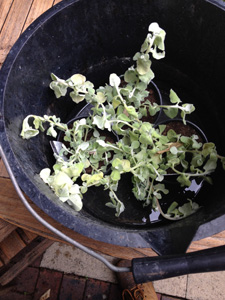Watering.
One of the main reasons home grown plants die, especially in pots and containers, is either too much or too little water. Water plants frequently in warm weather, especially if they are under cover, in a conservatory or greenhouse. But don't let them sit in saucers or trays of water, with the obvious exceptions of aquatic or bog plants.
Plants growing close to or next to a wall, will typically be in a 'rain shadow' so the roots will get little or no water. Water them well, particularly in warm weather before applying a thick mulch to retain the moisture.
To make sure that you are watering pots and planters with sufficient amounts of water, scrape away the top inch of compost and check that it is moist.
Briefly watering so just the surface of the soil becomes wet will encourage plants to grow a shallow root system, which isn't too much of a problem with bedding plants, but it is obviously more important that you give a good drenching to trees and shrubs.
When is the best time to water?
Plants use water, and carbon dioxide, in photosynthesis which only happens with the addition of light, i.e. during the day, so the 'best' time to water plants is in the morning, the plant can then use this moisture throughout the day. Note: if you notice that the soil is dry then the best time is straight away.

Over the summer, particularly if it's been hot or we've had a dry period, an additional late afternoon or early evening water may be necessary, leaving the watering too late in the evening, will mean the plant sits in water as it won't give the plant time to draw up the water until the following morning.
In the autumn and winter, if it hasn't rained for a few days and the soil is dry, water in the morning, watering in the evening leaves the plant roots wet and cold overnight, which can lead to rot.
Water at the base of the plant, if you wet the leaves, especially when it's sunny can cause the water droplets to magnify the sunlight, scorching the leaves.
If at any time you have a plant that is wilting or obviously dry (as in photo above), water immediately, plunging any that are in pots, into a bucket of water for 10-15 minutes.
Watering different soil types
Because of its structure, plants grown in sandy soil will need to be watered with less water but more often. Plants in heavy, clay soil will need less frequent watering, but more water in each instance.
It should be assumed that the compost in pots, containers and hanging baskets fall into the sandy soil category.
Watering seedlings
When watering seedlings use mains water rather than water from a water butt, as this can introduce infection and use a fine rose on a small watering can or mist with a sprayer to avoid washing away the seeds or knocking over the seedlings.
Watering cans
The long spout of a watering can enables the watering at the base of the plant, getting water to the roots and leaving the surrounding soil drier, which can reduce the amount of moisture available for weeds.
You don't need a watering can for indoor plants, use a measuring jug, or a freshly filled kettle instead.
